Jumping into social media marketing for the first time? You’re definitely not alone. As per the DataReportal report, over 5.4 billion people worldwide use social media, which is more than half the planet! With numbers like that, it’s clear why brands of all sizes are eager to get a piece of the action.
But here’s the catch: social media marketing can feel like a giant puzzle. Which platforms should you focus on? What kind of content actually works? And how do you keep up without burning out?
That’s where this guide comes in. We’re breaking down the basics to help you build a strong foundation, step by step. Plus, we’ll show you how using smart social media management tools—like our platform—can save you time and boost your results.
Whether you’re a small business owner, a marketer, or managing multiple clients, this guide will help you turn those billions of users into real engagement and growth.
Ready to get started? Let’s dive in!
Social Media Marketing, or SMM, is pivotal for modern digital marketing strategies.
How?
At its core, social media marketing is the strategic utilization of social media platforms to foster brand growth, drive sales, and increase website traffic. This isn’t merely about posting content; it’s a comprehensive approach that leverages platforms to cultivate connections, engage with existing and potential customers, and harness data analytics for refining marketing strategies.
Platforms such as Facebook, X (formerly Twitter), Instagram, and others have revolutionized the way businesses influence consumer behavior. From the pioneering days of MySpace to today, where over 59% of the world’s population engages with social media, the digital landscape has witnessed a profound transformation.
The essence of social media marketing guide strategies lies in their ability to connect, interact, and gather invaluable customer insights. This not only facilitates engagement but also paves the way for more targeted social media campaigns.
As we delve deeper into the top platforms for social media marketing in the subsequent sections, it becomes evident why businesses are heavily investing in SMM: the potential is vast, and the benefits are compelling.
But before that, let’s list what social media marketing includes.
So, we know social media marketing is crucial for successful online brand campaigns. But what exactly does it encompass?
Let’s list them.
1. Strategy Development
Every successful social media marketing campaign starts with a well-defined strategy. This involves setting clear goals, identifying the target audience, and selecting the most effective platforms for your brand. It’s essential to understand what content will engage your audience and the best time to post on social media.
A strategy acts as a roadmap, guiding your actions and ensuring alignment with your business objectives.
2. Content Creation and Publishing
Content is the heart of social media marketing. It’s not just about creating posts but ensuring they are relevant and timely.
The content should align with the interests of your target audience and be customized for each platform. This is where social media marketing tools come in handy. Consistently updating your content ensures your brand remains top-of-mind for your followers.
3. Analytics and Performance Tracking
Data-driven decisions are paramount, especially in this digital age. By leveraging social media analytics tools, brands can gain insights into engagement rates, click-throughs, and conversion metrics. This data serves as a feedback loop, highlighting what’s working and where improvements are needed.
So, what’s the bottom line?
Regularly reviewing these metrics ensures that strategies are optimized, campaigns are effective, and resources are allocated efficiently. In essence, analytics provides a roadmap for continuous improvement.
4. Paid Advertising
While organic content lays the foundation, paid advertising supercharges a brand’s reach on social media.
And here’s the best part…
With platforms like Facebook offering granular targeting, brands can ensure their content reaches the most relevant audience segments. With paid promotions, brands can amplify their message, drive targeted traffic, and achieve specific campaign objectives. It’s a strategic blend of organic and paid efforts that yields the best results.
5. Platform-Specific Approaches
The diverse landscape of social media channels requires a tailored approach for each.
But wait, there’s a twist…
Instagram, with its visual-centric nature, demands high-quality imagery, while LinkedIn, a professional network, values insightful articles and industry news. It’s crucial to understand and respect the unique characteristics of each platform; only then can brands craft content that resonates, engages, and drives action. It’s this nuanced approach that differentiates successful campaigns from the rest.
6. Integration With Broader Marketing Efforts
Social media is a powerful tool, but its true potential is unlocked when integrated with broader marketing initiatives.
What does that mean?
Whether it’s email campaigns, SEO efforts, or offline events, a cohesive and consistent brand message across channels amplifies impact. This holistic approach ensures that audiences receive a unified brand experience, irrespective of the touchpoint, enhancing recall and engagement.
7. Community Building
At its core, social media is about relationships.
Why is that important?
It offers brands an unparalleled opportunity to build social media communities, foster discussions, and engage in meaningful interactions. By nurturing these relationships, brands can transform casual followers into brand advocates. This community-centric approach drives engagement and fosters loyalty, turning social media platforms into thriving hubs of brand enthusiasts.
8. Use of Management Tools
Efficient management is crucial in today’s multi-platform environment.
But there’s a silver lining.
Social media management tools like SocialPilot offer a centralized dashboard for scheduling, monitoring, and analyzing social media activity. When you streamline these processes, brands can ensure consistency, timely engagement, and data-driven decision-making. In essence, a tool like SocialPilot can act as a command center, optimizing social media efforts for maximum impact.
And, yes!
We know you’re curious about how SocialPilot can aid your social media marketing efforts. We’ll cover this more in-depth later in this article.
For now, let’s discuss the…
Mastering the top social media marketing platforms is crucial in today’s digital landscape. While every platform can propel businesses towards their marketing goals, there’s a twist: not all are a fit for every business type.
Let’s give you something to think about.
Take a fashion brand, for instance; marketing its latest collection on LinkedIn might miss the mark. So, as you navigate this social media marketing guide, you’ll discover the nuances of each platform.
Curious about making the best marketing decisions?
Let’s delve into each platform’s strengths and how they can elevate your brand’s presence.
1. Facebook
Monthly active users: 3 billion+
Suitable for: B2C marketing
Used for: Advertising and brand building
Facebook, the largest social media platform globally, serves as a massive local business directory. With its diverse user base, it’s a hub for communication, group participation, business discovery, and brand following. It’s not just about connecting; it’s about marketing.
Brands can leverage Facebook’s vast reach and tools to target specific demographics, ensuring their content reaches the right audience. With its ad platform and analytics, businesses can track and optimize their campaigns for maximum ROI.
2. Instagram
Monthly active users: 1.6 billion
Suitable for: B2C marketing
Used for: Advertising, brand building, UGC content
Instagram’s rapid growth has positioned it as a leading platform for visual content. Its emphasis on high-quality visuals, from photos to stories, makes it a hotspot for B2C brands.
The platform’s features, like shoppable posts, allow businesses to seamlessly integrate commerce, making the shopping experience more interactive. Moreover, user-generated content (UGC) on Instagram provides authentic endorsements, amplifying brand credibility.
3. YouTube
Monthly active users: 2.29 billion
Suitable for: B2B and B2C marketing
Works for: Long-form entertainment content, advertising, brand awareness, tutorials, and how-tos
YouTube isn’t just for entertainment; it’s a platform for education, brand building, and community engagement. From product tutorials to webinars, brands can utilize YouTube to provide value, establish authority, and build trust. Its algorithm promotes content discoverability, ensuring that quality content reaches a broader audience. For businesses, YouTube ads offer another avenue to increase visibility and drive conversions.
4. TikTok
Monthly active users: 1.6 Billion
Suitable for: B2C marketing
Works for: Short-form entertainment content, advertising, and brand awareness
TikTok’s rise is a testament to the power of bite-sized content. Its algorithm-driven feed ensures that engaging content gets visibility. For brands, it’s an opportunity to showcase creativity, connect with younger demographics, and ride trending waves. With its in-app shopping features and advertising options, businesses can drive both brand awareness and sales.
5. LinkedIn
Monthly active users: 930 million
Suitable for: B2B marketing
Works for: Professional networking, B2B relations, business development
LinkedIn is more than just a professional networking site; it’s a hub for industry insights, thought leadership, and B2B marketing. Companies can share updates, publish articles, and engage with industry peers.
Its ad platform allows for precise targeting based on professional criteria, ensuring that content reaches decision-makers. For B2B brands, LinkedIn is invaluable for lead generation and relationship building.
6. Pinterest
Monthly active users: 463 million
Suitable for: B2C marketing
Works for: Visual advertising, inspiration, and ideas
Pinterest stands out as a platform for discovery. Users pin ideas, from home decor to fashion, making it a goldmine for brands offering niche products. Its visual search capability and shoppable pins streamline the user journey from discovery to purchase. For brands, it’s a platform to showcase products in real-world scenarios, driving both inspiration and sales.
7. X (Formerly Twitter)
Monthly active users: 450 Million
Suitable for: B2C marketing
Works for: Community building, customer service, and brand awareness
X’s real-time nature makes it a hub for news, updates, and conversations. Brands can leverage it for real-time engagement, customer service, and trend participation. With features like X Spaces, brands can host live audio discussions, deepening community engagement. Its ad platform, combined with organic engagement, can amplify brand messages, ensuring they resonate with the audience.
In light of this information, it’s evident that each platform offers unique benefits. The key is to align platform strengths with business objectives, ensuring that social media efforts drive tangible results.
Once you choose the right platform or platforms for your business, it’s time you learn about…
Crafting a robust social media marketing strategy is not just about posting content; it’s about weaving a narrative that resonates with your audience and drives engagement.
Here’s how you can achieve that:
Begin by reflecting on your overarching business goals.
Whether you aim to boost sales, enhance customer experiences, or simply spread the word about your offerings, social media can be a powerful tool. By integrating your business objectives with your social media goals, you can create a cohesive action plan.
For instance, if you’re looking to boost sales by 20% this year, consider leveraging social selling on platforms like Facebook, tailoring your campaigns to specific channels and timeframes.
2. Analyze Your Target Audience and Competitors
Knowledge is power.
Dive deep into social analytics to understand both your potential customers and competitors. Grasping who your audience is, their preferences, and where they spend their time online can shape your content strategy.
Similarly, observing your competitors can offer insights. Ask questions like:
What type of content are they posting?
How do they engage with their audience?
By answering these questions, you can carve out a unique space for your brand in the crowded social media landscape.
3. Focus on an Inbound Approach
After gaining insights about your audience, it’s crucial to determine how you’ll engage them. The inbound marketing strategy emphasizes attracting customers through relevant and helpful content, adding value at every stage in your customer’s buying journey. Instead of pushing out messages, the focus is on addressing the problems and needs of your customers.
A popular guideline in this approach is the 70:20:10 rule for social media content: 70% should be informational, 20% should focus on emotional marketing, and only 10% should be promotional.
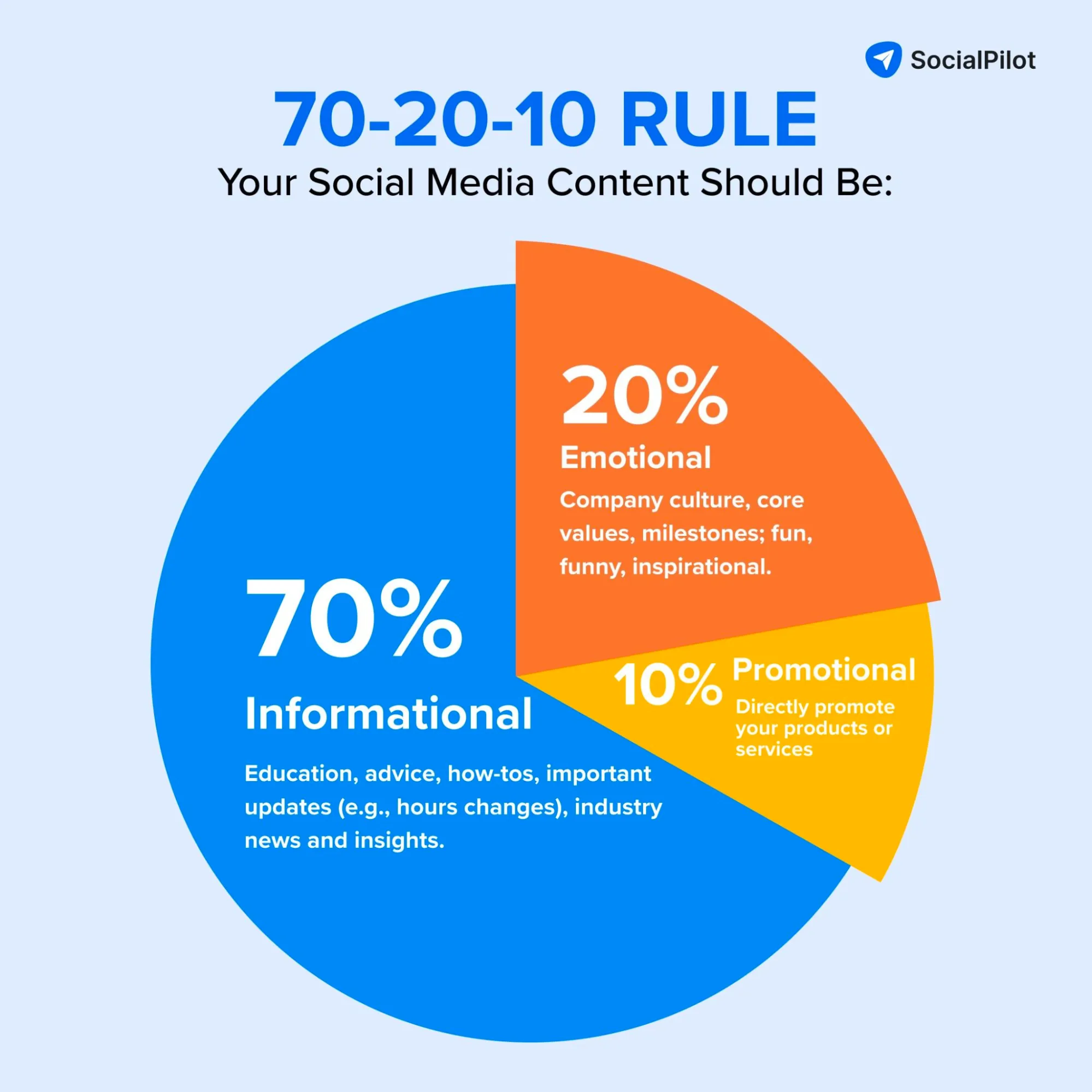
This approach ensures that you’re building genuine relationships with your audience, fostering trust, and positioning your brand as a valuable resource.
Not all platforms are created equal.
Depending on your brand and target demographic, some channels might be more effective than others. For instance, while Facebook and Instagram are universally popular, offering a mix of shopping tools and visual content, platforms like LinkedIn might be more suited for B2B interactions.
Once you’ve selected your platforms, it’s crucial to determine the best times to post. This ensures your content reaches the maximum number of eyes and garners the engagement it deserves.
To streamline this process, consider using SocialPilot’s Social Media Calendar.
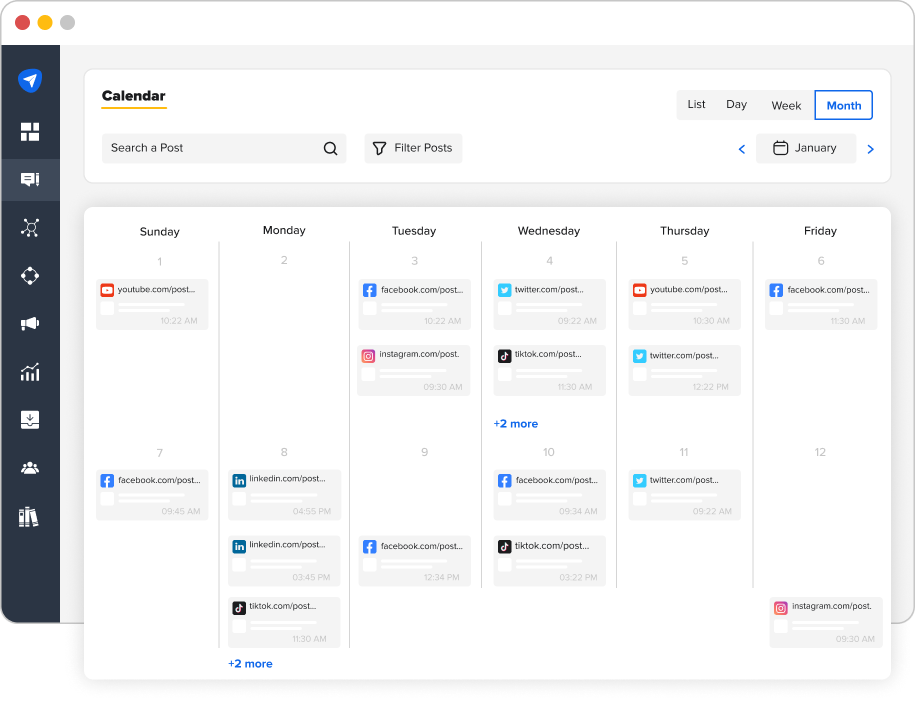
This not only enhances your social media strategy by allowing you to plan, schedule, and publish all from one place but also offers a visual representation of your content strategy.
With features like a ‘monthly plan view’ for a broader perspective and ‘day view’ for detailed insights, you can achieve a 360-degree visualization of your social media strategy, ensuring you never miss an optimal posting time.
5. Establish Key Performance Indicators (KPIs)
What gets measured gets managed. When you set clear KPIs, you can track the effectiveness of your social media strategy.
What could these KPIs be?
This could range from monitoring profile impressions and engagement rates to tracking click-through rates and audience growth. Remember, it’s essential to have a baseline. Gather data on your current performance and industry standards to set realistic and ambitious targets.
Consistency is key in the world of social media. So, ensure you organize your content strategy with a social media scheduler.
Why?
This not only helps in ensuring a steady stream of content but also in maintaining a consistent brand voice. Consider creating templates for recurring posts and batching similar tasks. This proactive approach means you can spend more time engaging with your audience rather than scrambling for last-minute post ideas.
7. Regularly Assess and Adjust Your Strategy
The digital landscape is ever-evolving. As such, it’s vital to keep a pulse on your strategy’s performance and be ready to pivot when necessary.
Set aside time, be it monthly or quarterly, to review your metrics, evaluate your content’s effectiveness, and keep an eye on emerging trends. Remember, social media marketing is akin to a marathon, not a sprint. It’s about building lasting relationships, strengthening your brand, and driving sustained growth over time.
By carefully following these steps and staying tuned into the ever-changing world of social media, you can build a strategy that truly connects with your audience and drives real business results. For more practical ideas, check out these social media marketing tips that can help you fine-tune your approach.
Now, let’s discuss the benefits social media marketing brings to you.
With over half of the world’s population using social media, marketers and businesses can’t afford to exclude it from their marketing strategies.
But why is social media marketing such a big deal?
Let’s dive into the next aspect of our social media marketing guide and explore its myriad benefits.
1. Building a Robust Brand Identity
Social media is more than just a platform for posting content; it’s a goldmine for brand building.
Think about it.
By showcasing behind-the-scenes moments, team highlights, and customer testimonials, you’re giving your brand a face and a personality. This human touch makes it easier for customers to connect with you and build trust on social media. Moreover, when you share industry insights, research findings, and expert opinions, you position your brand as a go-to source for valuable information.
Consistency in your posts and interactions fosters trust and loyalty among your audience.
Take Wendy’s, for example.

Their X game, with witty comebacks and humorous posts, isn’t just about selling burgers; it’s about creating memorable interactions that make them stand out in the crowded fast-food space.
2. Drive Traffic Like a Pro
Did you know that social media can be a major traffic driver for your website?
The secret lies in the combination of engaging content and strong CTAs. While your content grabs attention, a compelling Call to Action nudges users to click and explore more.
When you share informative articles, how-to guides, and industry news, you’re positioning your brand as not just promotional but also helpful and trustworthy.
3. Always on Your Customer’s Radar
The old saying goes, “Out of sight, out of mind.” But with social media, you have the power to change that narrative.
Regular updates about product launches, special offers, and company news are essential, but there’s more to staying visible.
What is it?
User-generated content, like reviews and testimonials, can be shared to showcase real-life experiences with your brand, fostering trust and credibility. Hosting live sessions or Q&As can create a sense of community, making your audience feel more connected.
Engaging in trending topics and challenges keeps your content fresh and taps into what’s currently capturing your audience’s attention. Collaborations with influencers or complementary brands can expand your reach, introducing your brand to new audiences.
An interesting example?
Starbucks, for instance, has mastered the art of staying relevant. Their blend of product promotions, engaging content, and seasonal campaigns ensures they’re always top-of-mind for coffee lovers. By diversifying your content and actively engaging with your audience, you ensure that your brand remains a consistent presence in their daily social media scroll.
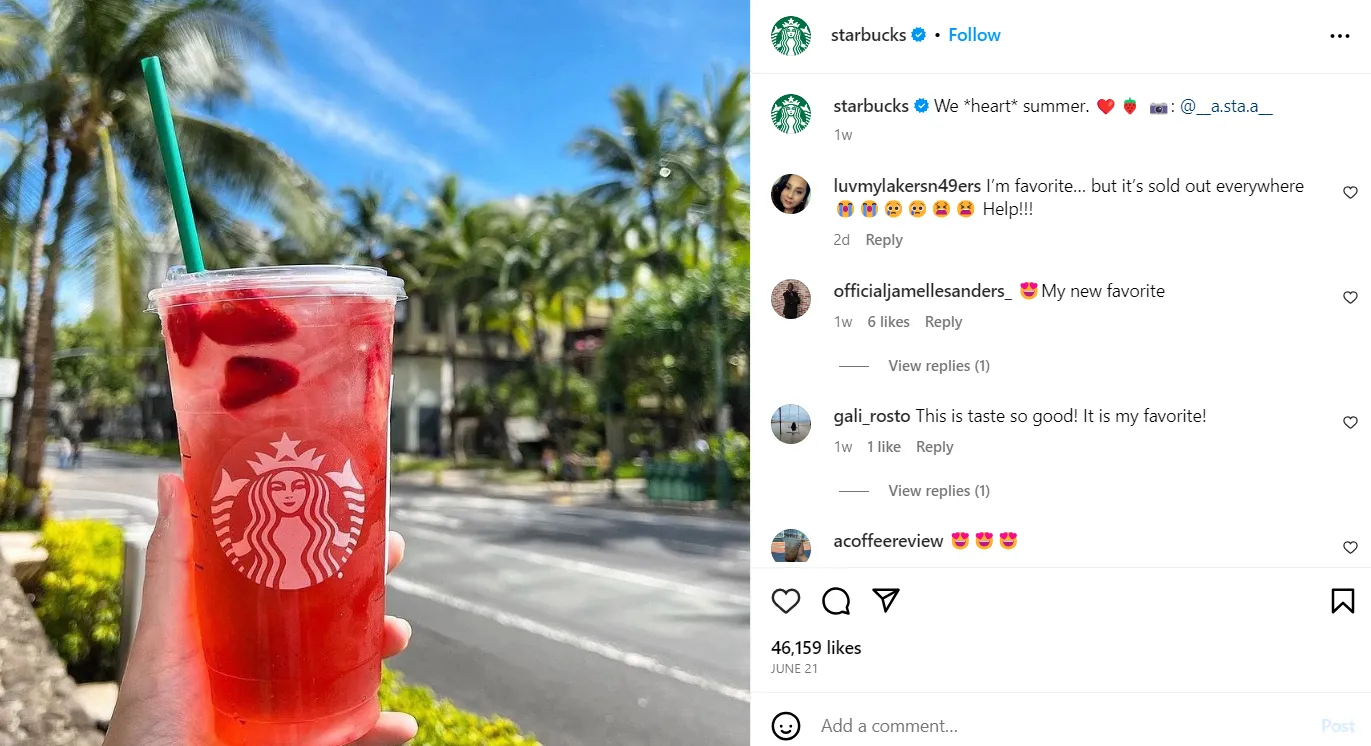
4. Attract Top-of-the-Funnel Leads
Social media isn’t just about likes and shares. It’s a potent tool for capturing leads, and here’s why.
Offering a diverse range of content, from infographics to webinars, caters to different audience preferences.
But there’s more to it.
Interactive content formats like polls, quizzes, and challenges can engage users, making them more likely to share their contact information. Plus, with targeted campaigns and remarketing strategies, you’re not just reaching potential customers; you’re nurturing them.
Platforms like Facebook and LinkedIn offer advanced targeting options, allowing you to reach the right audience based on demographics, interests, and behaviors. Furthermore, integrating your social media with CRM tools can help streamline the lead management process, ensuring no potential customer slips through the cracks.
5. Elevate Your Customer Service
The beauty of social media lies in its immediacy, but there’s a depth to it that many businesses overlook. It has revolutionized customer service, allowing brands to address concerns, answer queries, and resolve issues in real time.
But it’s also a platform for proactive engagement.
You can jump into conversations by monitoring mentions and industry-related keywords, offering solutions before a customer even reaches out.
JetBlue, for example, showcases its commitment to customer satisfaction with its proactive approach on X.

But remember, it’s essential to choose the right platform.
While X excels at quick interactions, platforms like Instagram might be better suited for showcasing user-generated content. Additionally, using chatbots on platforms like Facebook Messenger can provide instant responses to frequently asked questions, ensuring customers get answers even outside business hours.
6. Personalized Experience for Consumers
One of the standout benefits of social media marketing is its ability to deliver a tailored experience for users.
How?
Brands with effective social media strategies can target their audience based on various factors, including demographics, shopping patterns, and interests. This means that consumers are more likely to see posts and advertisements that align with their personal preferences and needs.
Such personalized content enhances user engagement and leads to higher conversion rates. When consumers feel that a brand understands and caters to their specific interests, they are more likely to engage and build loyalty with that brand.
7. Clear and Comprehensive Product Information
In today’s digital age, consumers are more informed than ever. While traditional in-store visits might limit them to the information available on product labels, social media provides a platform for brands to offer detailed insights about their products or services.
Through posts, videos, and other forms of content, brands can provide comprehensive information, helping consumers make well-informed purchase decisions. This transparency not only aids in the decision-making process but also builds trust between the brand and its consumers.
Product marketing is essential for most brands these days, so it is important that you avoid some common pitfalls of it. Let’s discuss them in the section below.
What are the most common social media marketing mistakes a ton of marketers make? Here are seven common ones.
1. Overposting or Underposting
Striking the right balance in posting frequency is essential. Some marketers post aimlessly, hoping to capture as many customers as possible, much like a fisherman casting a wide net.
However, this approach can backfire.
While platforms like Facebook might suggest 1-2 posts per day for optimal engagement, Instagram’s feed might thrive with 3-7 posts per week.
Achieving this balance ensures you neither annoy your followers with excessive content nor let them drift away due to infrequency. Remember, the optimal time to post on social media is essential. If you post too frequently, you risk overwhelming your followers; if you post too infrequently, they might forget about your brand.
As per industry standards, here is what the ideal posting frequency should look like for each social media platform:
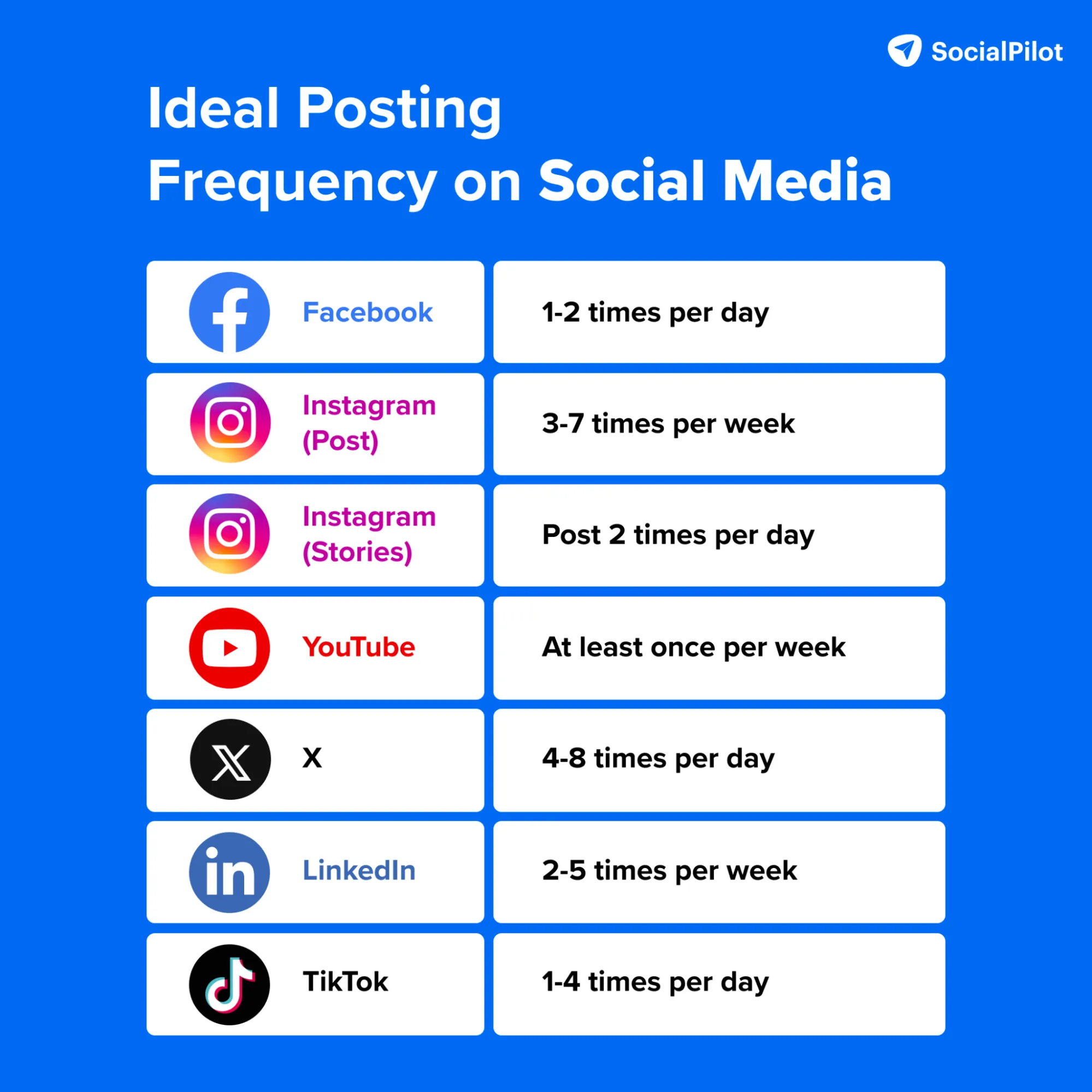
2. Having a One-Size-Fits-All Content Approach
Your content mix plays a crucial role in the success of your social media marketing. Content creation is the most time-consuming process in social marketing, and it requires a tailored approach.
Platforms offer unique features like Instagram Stories, Facebook Live, or X polls. Diversify with posts, Reels, infographics, and Stories to match your audience preferences.
What’s also important?
Make sure to incorporate a mix of promotional, educational, entertaining, and user-generated content to provide value to your followers. Tailor your content mix to suit each platform and audience segment for maximum engagement.
Here is how different content types fall in the three stages of the social media marketing funnel:
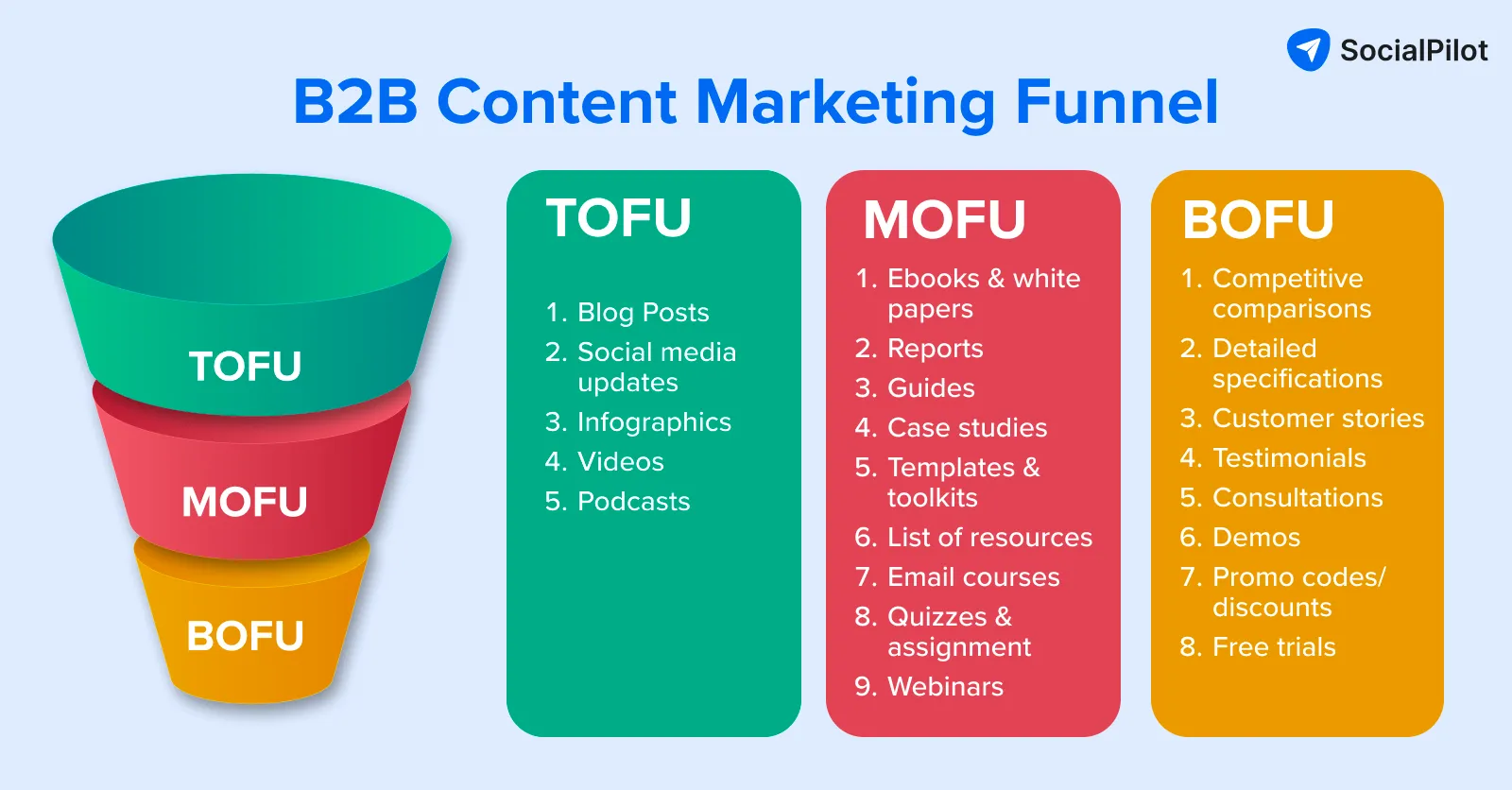
3. Neglecting Content Creation Tools
Not using adequate resources while marketing is one of the biggest mistakes marketers and businesses commit. Content creation tools are one such resource for social media marketers.
Why?
These tools can help you streamline your content creation process and develop post and Reel content without a hefty investment in design.
Some of the free content creation tools you can use are:
- Canva
- Adobe Spark
- Unsplash
- Figma
- InShot
- iMovie
These tools will help you create interesting Stories, posts, and Reels for social media without any design experience. However, to make your visual content outrank your competitors, you must also accompany it with relevant text content.
And what’s the best solution for this? SocialPilot AI Assistant!
Designed to revolutionize your content strategy, it effortlessly generates engaging post ideas, recommends tailored hashtags, and optimizes content for different social platforms. Say goodbye to those creative blocks and manual brainstorming. With SocialPilot, you have a trusted ally to ensure your content consistently resonates and captivates your target audience.
Want to see the AI Assistant in action? Watch the video below to discover how it can supercharge your social media content creation.
4. Overlooking Audience Engagement
Social media thrives on interaction and engagement. It’s not just a platform to broadcast messages but a space to foster genuine connections.
An interesting example?
Leading brands like Nike have demonstrated the power of active engagement. They don’t just post content; they interact, share user-generated content, and provide insights into their brand’s ethos, as seen with their streetball reel.
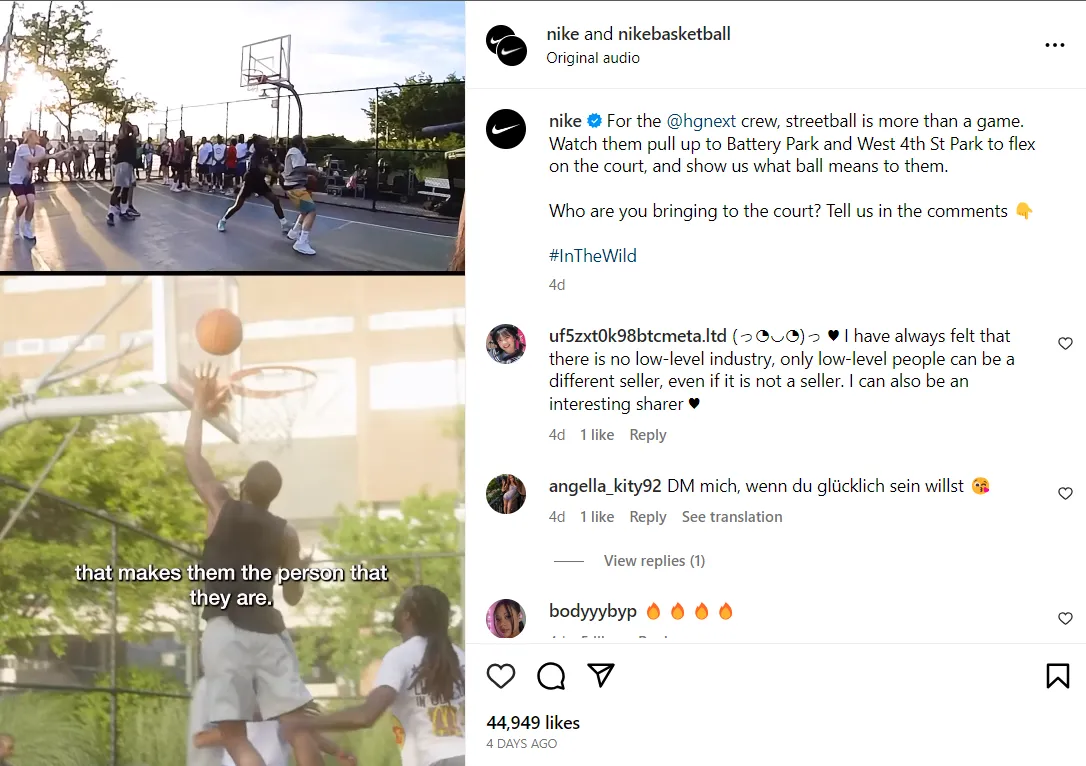
Engaging isn’t just about responding; it’s about initiating meaningful conversations, asking your audience for their opinions, and valuing their feedback. When you show genuine interest in what your followers have to say, it builds trust and loyalty. This positions your brand as one that truly values its community and fosters a sense of belonging among your followers.
5. Reposting Without Strategy
While repurposing content on social media platforms can be a smart move, it’s essential to have a strategy.
For instance, a high-performing blog on your website can be transformed into an engaging infographic summarizing its key points.
You can also leverage customer testimonials.
Positive feedback from satisfied customers can be showcased across various platforms, reinforcing trust and credibility. Moreover, testimonials can be visually enhanced to make them more appealing.
How?
A simple text testimonial can be transformed into a visually captivating post using the right template. This approach ensures that you’re not just recycling but rejuvenating content, making it fresh and appealing to different audience segments.
And where do you find the right template to seamlessly showcase your testimonials?
SocialPilot offers ready-made social media templates for testimonials that make sharing customer stories a breeze, elevating your online reputation and engagement effectively.
Free Social Media Templates for Testimonials
Easily create social media posts to showcase user reviews and testimonials
By reposting popular or evergreen content, you can ensure that your content reaches a wider audience and maintains visibility over time.
6. Relying Solely on Organic Reach
Organic content is undeniably crucial in building genuine relationships with your audience and increasing organic reach. However, relying solely on it can limit your brand’s reach and potential. Paid social media advertising offers a targeted approach to reach specific demographics, ensuring your content is seen by those most likely to engage and convert.
Here’s a good example:
Brands like Nike exemplify this balance. While they’ve built a strong organic presence, they also leverage paid social campaigns to promote a lifestyle, drive direct traffic, and boost sales.
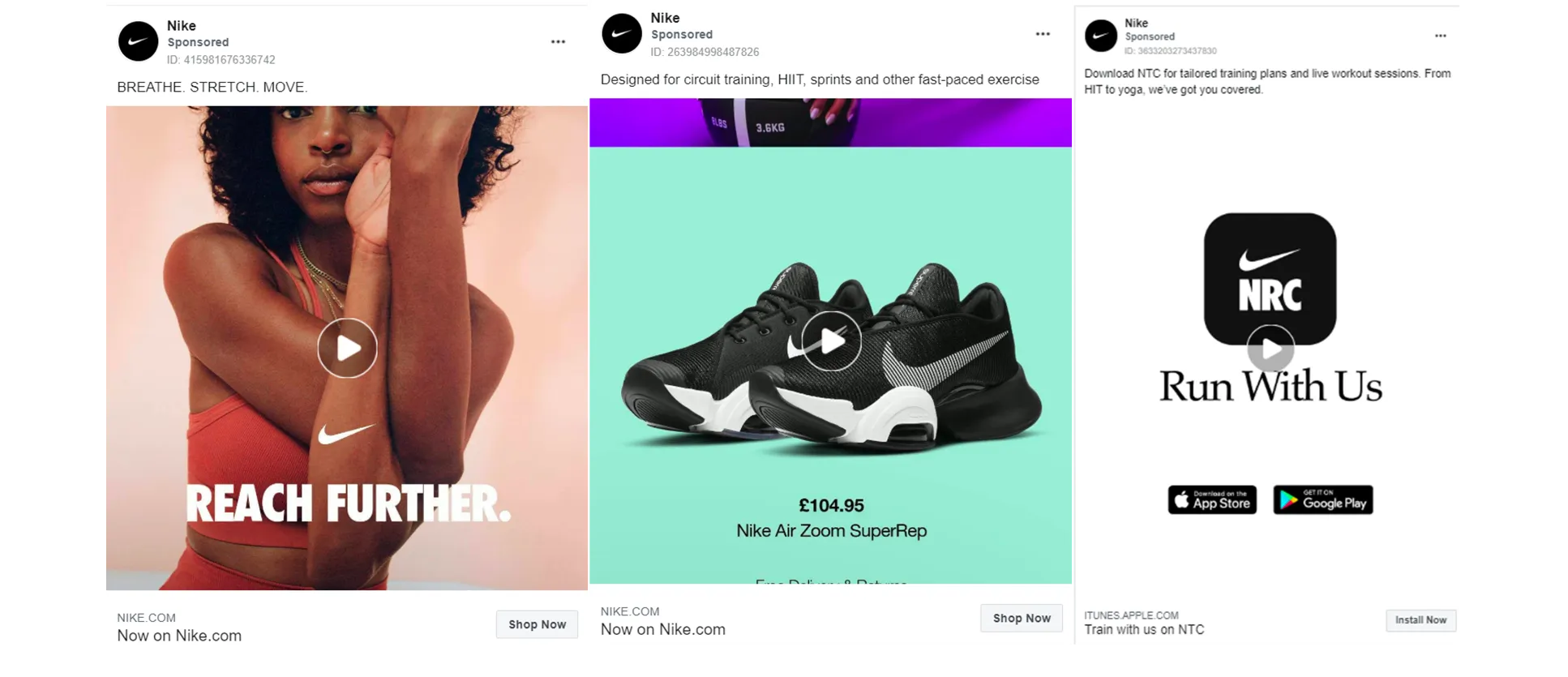
Platforms like Facebook and Instagram offer robust targeting options, allowing you to precisely reach your ideal audience. Experiment with different ad formats, such as image ads or carousel ads, to find what resonates best with your audience. Remember, a balanced approach combining organic and paid strategies can significantly amplify your reach and impact.
7. Not Regularly Evaluating Performance
The digital realm is ever-evolving. Strategies that were once effective might need adjustments. Regularly using analytics tools to track metrics like social media ROI, reach, and engagement is crucial.
This data-driven approach ensures you’re always in tune with your audience’s preferences, allowing you to refine your strategies and stay ahead of the curve. Constantly evaluate the performance of your social media campaigns to gather insights and improve your tactics. Here’s a great resource on how to improve your social media marketing while avoiding the above mistakes and achieving strategic goals.
Before we reach the end of this article, let’s convince you of the importance of social media marketing with these interesting statistics.
In the dynamic landscape of social media marketing, standing out amidst the noise is challenging.
SocialPilot emerges as a beacon for businesses and marketers, offering a suite of tools tailored to amplify your brand’s voice, engage audiences, and drive measurable results. As social media platforms continue to evolve and user behaviors shift, having a tool like SocialPilot ensures you’re not just keeping up but leading the charge.
Key Features of SocialPilot:
- Unified Social Media Management: Connect and manage up to multiple social profiles with the unified dashboard, ensuring consistent posting across various platforms. Schedule a single post multiple times, catering to different audience time zones and preferences.
- In-depth Analytics: SocialPilot offers a robust analytics tool, allowing marketers to gauge the performance of their content, understand audience engagement, and refine strategies based on real-time data.
- Social Inbox: Engage with your audience in real-time. Respond to comments, messages, and posts across platforms like Facebook, ensuring you never miss a conversation.
- Team Collaboration: Manage your social media campaigns collaboratively. Assign tasks, review posts, and ensure a cohesive brand message across all platforms.
- AI Assistant: With the AI Assistant, you can generate captivating captions, discover relevant hashtags, and tailor content for each platform. This feature ensures your content remains fresh, engaging, and in line with current trends.
- Visual Content Strategy: The platform’s social media calendar provides a visual representation of your posting schedule, ensuring consistency and strategic alignment with events or campaigns.
- Bulk Scheduling: Plan ahead by scheduling up to 500 posts in advance, allowing for flexibility and strategic content dissemination.
Conclusion
Social media marketing is a vast and ever-evolving landscape that requires a solid understanding of many moving parts to truly succeed. We hope this guide has given you the insights and confidence to effectively promote your products and services in this dynamic space.
If you want to dig deeper into understanding your audience, mastering paid advertising, or tailoring your approach for specific platforms, be sure to explore our in-depth blogs packed with expert tips and strategies.
And when you’re ready to streamline your efforts and boost your results, SocialPilot is here to help. Our all-in-one social media management platform simplifies content planning, publishing, monitoring, and analytics – giving you more time to focus on what matters most: growing your brand.
Curious about which plan fits your needs best? Take a look at our pricing plans and get started on your social media journey today!





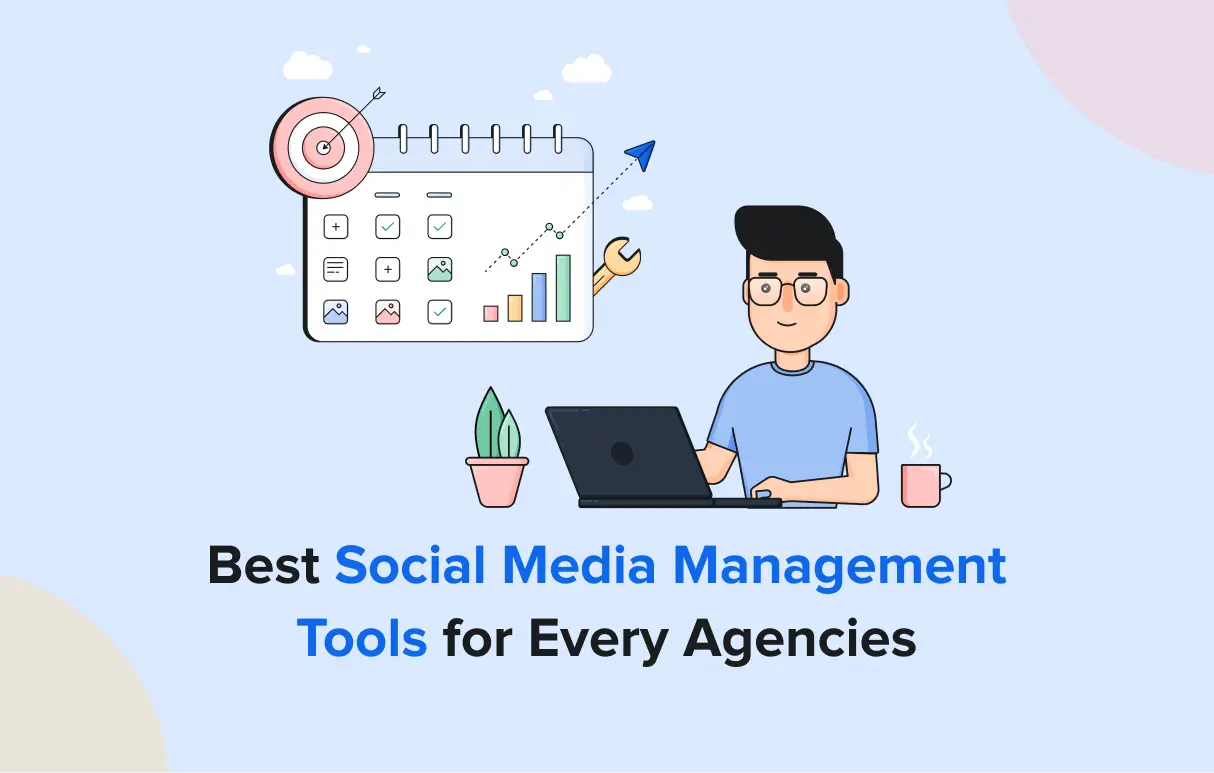
-min.png)